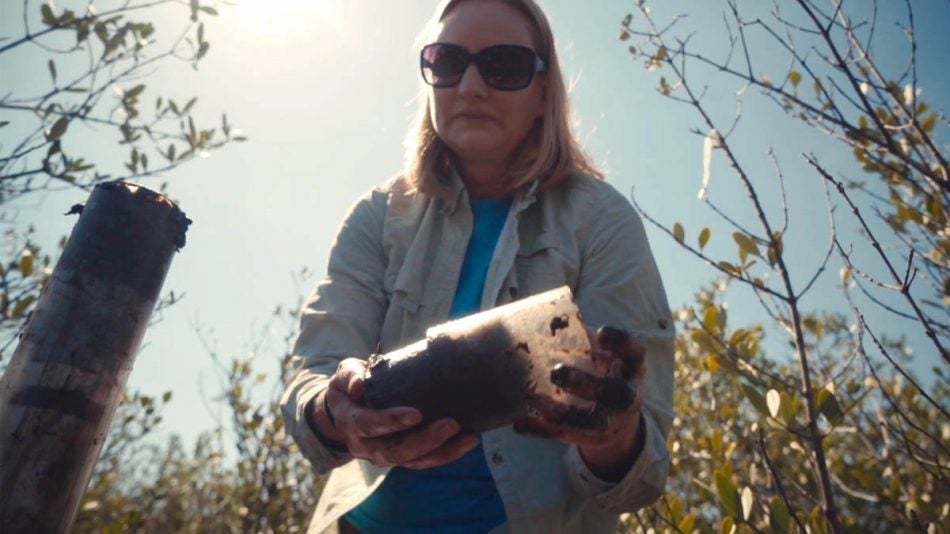It was the inaugural week of UCF’s Wetland Ecology and Biogeochemistry course. And to set a proper tone for the semester, Assistant Professor of Biology Lisa Chambers told students to wear their grubbiest clothes to class. She wanted them to get a good feel for field research — all the way from their fingertips to their toes. She’d supply the rubber boots.
“There’s no better place for us to study wetlands,” Chambers said before the students waded through thick vegetation and trudged through muck in search of soil samples to take back to the lab. They hadn’t even left the UCF campus. “We probably have more abundant wetlands on campus than any university in the country. It’s paradise for this type of work. We’re in the heart of the issue.”
“There’s no better place for us to study wetlands. … We’re in the heart of the issue.”
The “issue” is the relationship between wetlands and our changing environment. And Chambers knows the subject well. Her own interest was piqued while she was studying environmental science at Ohio State and heard a speaker from Louisiana discuss the loss of wetlands there. Chambers was so fascinated that she decided to do post-graduate work at Louisiana State, arriving just a few months after Hurricane Katrina devastated the area.
“That was a clear illustration of how natural buffers, like wetlands, work much better than manmade buffers, like seawalls,” she says.
The whole scenario inspired her to eventually dig deeper into wetlands research in the ideal location: UCF. It’s a short drive to the Gulf Coast, the Atlantic Coast, the Everglades, and an even shorter walk to the 386 acres of wetlands that belong to UCF.
“The dichotomy between development and pristine ecosystems makes it an ideal location for this kind of research,” Chambers says. “We can see how it all relates to climate change.”
An Interdisciplinary Approach to Coastal Research
Wetlands research at UCF does not exist in a bubble. Recently, the university launched the National Center for Integrated Coastal Research. The interdisciplinary initiative includes faculty from engineering, tourism, marketing, community politics, and biology, all offering expertise from different angles.
“To advance the science and really make a difference, we need input from people from different disciplines of science — social, political, physical,” Chambers says.
“The way I see it, we’re discovering positive feedback within our wetlands in relation to rising sea levels.”
The Center doesn’t make the subject of our changing environment any more daunting than already is. Yes, development has infringed on ecosystems. Yes, biogeochemistry students can use incubators and measure for themselves the rate at which greenhouse gases are released into the atmosphere. But doom and gloom are not required elements in this research.
“I have a different perspective than a lot of ecologists in that I’m an optimist about the resilience of nature,” Chambers says. “The way I see it, we’re discovering positive feedback within our wetlands in relation to rising sea levels.”
A Protective Buffer for our Atmosphere and Oceans
First, an elementary lesson on the quantity of bacteria found in soil. There are up to 40 million bacteria in one gram of soil (a pinch of dirt). The bacteria break down and dispense nutrients collected over decades and centuries — what we know as decomposition. One of the richest ecosystems in terms of bacteria are wetlands. More specifically, peatlands, which are warm and wet and found all Florida. Among the matter that peatlands collect? Carbon.

“It’s a very good thing,” says Chambers. “Peat accumulates carbon in high quantities and keeps it in the soil. It’s much better for carbon to be stored in peatlands rather than being released into our atmosphere or oceans.”
The way Chambers sees it through her research lens, even rising sea levels are not the end of the world. “There are no simple answers, but we do know from studying Florida’s peatlands that they have interesting mechanisms to survive.”
“ Nature is dynamic and is more resilient than we sometimes realize. Just because things look different doesn’t always mean it’s a bad thing.”
As saltwater inundates peat, the bacteria slow their decomposition process. The peat builds up vertically to stay above the water. Peatlands can also migrate, moving inland when necessary — as they’ve done off and on for centuries.
If anything, this is all the more reason to protect our peatlands from development. But rather than focus on putting the proverbial toothpaste back in the tube, the Center agrees we should work together to ensure there isn’t further encroachment on our wetlands. Business leaders. Politicians. Scientists. We all have a high stake in preventing a massive loss of CO2 into the atmosphere.
At the same time, Chambers’ research also shows we should not simply look at a changing landscape and assume the worst.
“We can see through the history of our wetlands that they won’t look the same in the future, no matter what,” says Chambers. “Look at a building five years after it’s abandoned, and there’s a tree growing through it. Nature is dynamic and is more resilient than we sometimes realize. Just because things look different doesn’t always mean it’s a bad thing.”
The evidence is right outside our doors, in the peatlands.




